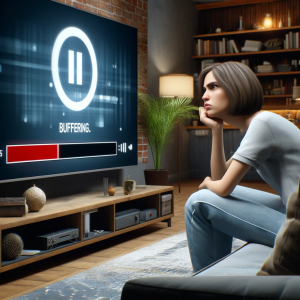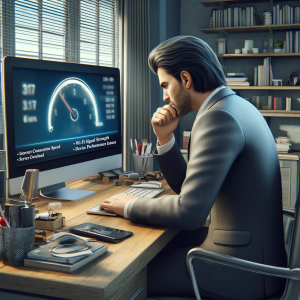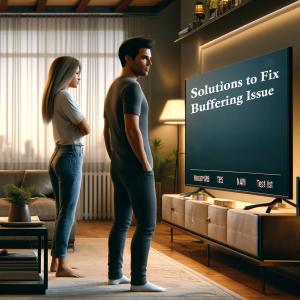Amazon Prime Video Buffering
In recent years, the landscape of digital entertainment has dramatically transformed with the rising prominence of streaming services. Among these, Amazon Prime Video has emerged as a favorite, boasting a vast library that caters to diverse tastes and preferences. As millions globally turn to Amazon Prime Video for their entertainment needs, the service’s ability to deliver seamless streaming experiences is more crucial than ever.
However, subscribers frequently encounter a frustrating hurdle—Prime Video buffering. This common issue disrupts the smooth flow of viewing and can detract significantly from the overall user experience. Buffering on Amazon Prime not only interrupts your movie night but can also pull you out of the immersive world of your favorite series, causing annoyance and dissatisfaction.
Understanding and resolving Amazon Prime keeps buffering issues is essential for maintaining the service’s reliability and viewer satisfaction. Buffering of Prime video can be due to various factors, including internet connectivity, server problems, or outdated devices. Regardless of the cause, it is imperative for both users and service providers to address these interruptions quickly. Doing so ensures that the streaming experience remains uninterrupted, keeping viewers engaged and subscribed.
As we delve deeper into the mechanisms behind buffering and explore effective solutions, it becomes clear that tackling these issues not only enhances individual viewing experiences but also bolsters the reputation and competitiveness of Amazon Prime Video in the bustling market of online streaming platforms. By addressing the root causes of Prime Video buffering and implementing robust fixes, Amazon can ensure that its users enjoy every film and show in the highest quality, with minimal disruptions.
Understanding Buffering of Amazon Prime Video
Buffering is a term that often comes up in discussions about streaming media, but what exactly does it mean? Essentially, buffering occurs when a streaming video pauses intermittently as it downloads additional content. This delay ensures that playback proceeds smoothly without interruption once the additional data is sufficiently pre-loaded. However, when Amazon Prime Video buffering becomes frequent, it can disrupt your viewing experience, making it crucial to understand and address the root problems.
Several factors can lead to Amazon video buffering, and pinpointing these can be crucial for troubleshooting:
-
Internet Connection Speed:
The most common culprit behind buffering on Amazon Prime is an inadequate internet connection speed. Streaming high-quality video content requires a stable and fast internet connection. If the connection speed drops below the necessary threshold, your videos will likely buffer as it tries to download enough data to continue playback.
-
Wi-Fi Signal Strength:
Even with a fast internet plan, poor Wi-Fi signal strength can impede your streaming experience. Obstacles like walls and floors can weaken the signal, as can the distance between your device and the router. Weak Wi-Fi can cause intermittent Amazon Prime video buffering, especially if you are streaming on a device far from the router.
-
Server Overload:
At times, the issue might not be on your end at all. Server overload, especially during peak viewing times, can cause Amazon video buffering. When too many users try to access the same content simultaneously, the server might struggle to deliver data efficiently to every user, leading to buffering.
-
Device Performance Issues:
The device you use to stream Amazon Prime Video can also impact your experience. Older or low-performance devices may struggle to handle high-definition video playback smoothly. This is particularly common with older smart TVs and first-generation streaming devices that might not have the processing power required to support steady streaming without buffering.
Understanding these factors is the first step in troubleshooting buffering on Amazon prime. Each cause requires a different approach to solve, ranging from upgrading your internet plan to enhancing your Wi-Fi setup or even considering newer, more capable streaming devices. Addressing these issues not only minimizes buffering on Amazon Prime but also improves your overall digital entertainment experience, making your movie nights or binge-watching sessions a seamless pleasure.
How to Diagnose Prime Video Buffering Problems
Encountering buffering on Amazon Prime can disrupt your streaming experience. To effectively address and resolve buffering issues, it’s essential to systematically diagnose the root cause of Amazon Prime Video buffering. Follow this detailed step-by-step guide to pinpoint why you’re experiencing buffering on Amazon Prime.
Check Internet Connection and Speed
Amazon Prime Video buffering often stems from inadequate internet speeds or connection problems. To diagnose this:
-
Test Your Internet Speed:
Utilize online speed tests to assess the internet speed. Adequate speeds are crucial for preventing buffering issues—typically, 5 Mbps for HD content and 25 Mbps for 4K content.
-
Monitor Bandwidth Usage:
Ensure no other devices are consuming significant bandwidth on your network. High traffic from other activities can lead to buffering on Amazon Prime.
-
Inspect Network Equipment:
Check your modem and router for any signs of issues. Restarting these devices can sometimes reduce buffering.
Test Different Devices
If your internet connection checks out, the next step is to determine if Amazon Prime Video buffering is isolated to a specific device:
-
Switch Devices:
Stream Amazon Prime Video on various devices (like smartphones, tablets, and smart TVs) to see if the buffering on Amazon Prime persists across all devices.
-
Evaluate Device Performance:
Some devices may have limitations or performance issues that can exacerbate Amazon Prime buffering issues. Identifying if one device is the source can narrow down the problem.
Check Server Status of Amazon Prime Video
Buffering on Amazon Prime might also be due to issues on Amazon’s end:
-
Check Service Outages:
Use platforms like DownDetector to see if other users are experiencing similar buffering issues, which might suggest server-related problems.
-
Follow Official Updates:
Amazon Prime Video’s social media pages can be a reliable source for updates if there are widespread buffering issues on Amazon Prime.
This structured approach helps in diagnosing buffering problems effectively. Each step is designed to isolate different potential causes of buffering on Amazon Prime, making it easier to identify specific issues and apply the appropriate solutions. By understanding and addressing the source of buffering issues, you can enhance your viewing experience and enjoy smoother streaming on Amazon Prime Video.
Solutions to Fix Buffering on Amazon Prime Video
Experiencing buffering on Amazon Prime can be quite frustrating, especially when you’re looking forward to relaxing and watching your favorite content. If Amazon Prime keeps buffering, there are several effective solutions you can implement to enhance your streaming experience. This section provides a detailed guide on how to address and fix buffering issues.
Enhancing Internet Speed and Stability for Amazon Prime Video
Buffering on Amazon Prime is often related to internet speed and stability. Here are a few ways to address these issues:
-
Choose the Right Internet Plan:
Ensure your internet plan provides sufficient speed for streaming Amazon Prime Video, especially if you watch in HD or 4K. If Amazon Prime keeps buffering, upgrading to a higher-speed plan might be necessary.
-
Optimize Router Settings:
Sometimes, simple adjustments to your router settings can improve speed and reduce Amazon Prime Video buffering. Consider setting your router to a less congested channel or enabling Quality of Service (QoS) settings to prioritize video streaming traffic.
Improving Wi-Fi Signal for Amazon Prime Video
A weak Wi-Fi signal can also cause Amazon Prime Video to keep buffering. Here are steps to boost your Wi-Fi:
-
Position Routers Optimally:
Place your router in a central location in your home away from walls and obstructions to maximize coverage.
-
Use Wi-Fi Extenders:
If your home has dead spots or long distances between your device and the router, using Wi-Fi extenders can help maintain a strong connection, reducing buffering on Amazon Prime.
Device Optimization
The device on which you stream Amazon Prime Video can also affect performance:
-
Clear Cache:
Over time, your streaming device may accumulate data that can slow it down. Regularly clearing the cache can free up memory and reduce buffering issues.
-
Update Amazon Prime Video App and Operating Systems:
Ensure your device’s operating system and the Amazon Prime Video app are up-to-date. Updates often include performance improvements that can minimize buffering on Amazon Prime.
Alternative Solutions for Amazon Prime Buffering Issues
If the above solutions don’t fully resolve the buffering issues on Amazon Prime, consider these alternatives:
-
Lower Amazon Prime Video Quality Settings:
While it might not be ideal, lowering the streaming quality settings in Amazon Prime Video can significantly reduce buffering. This is particularly useful during peak internet usage times.
-
Watch During Off-Peak Hours:
Try streaming during times when fewer users are online, such as early mornings or late evenings. This can help avoid Amazon Prime Video buffering due to high traffic on your ISP’s network.
Implementing these solutions can dramatically improve your streaming experience by addressing and fixing the common causes of buffering. With a little bit of troubleshooting and optimization, you can enjoy smoother playback and fewer interruptions on Amazon Prime Video.
Advanced Troubleshooting Tips for Amazon Prime Buffering
For viewers who continually face buffering on Amazon Prime, diving deeper into advanced troubleshooting techniques can often resolve persistent buffering issues. This section outlines several technical solutions that can improve streaming performance for users dealing with stubborn buffering problems.
Changing DNS Settings
One overlooked aspect that might contribute to Amazon Prime Video buffering is the Domain Name System (DNS) settings. DNS is responsible for translating website addresses into IP addresses. Sometimes, the default DNS servers provided by your Internet Service Provider (ISP) may not perform optimally, leading to slower internet responses:
-
Select a Faster DNS Server:
Switching to a public DNS server like Google DNS or OpenDNS can increase your internet speed and potentially reduce buffering on Amazon Prime.
-
Configure DNS Settings:
You can change the DNS settings directly on your router, which affects all devices on your network, or on individual devices, depending on your preference and needs.
VPN Usage and Its Impact on Streaming
There are instances where using a Virtual Private Network (VPN) can affect streaming speeds due to encryption overhead and the physical distance data travels to the VPN server:
-
Evaluate VPN Settings:
If Prime Video keeps buffering while using a VPN, try switching to a server closer to your location or disabling the VPN to see if performance improves. Remember, some content might be geo-restricted, and turning off the VPN could limit access depending on your region.
-
Choose the Right VPN:
Not all VPNs handle high-bandwidth activities like streaming well. Opt for a VPN known for fast speeds and stability to minimize buffering on Amazon Prime.
Contacting ISP for Specific Streaming Issues
If all else fails, the problem might be with your Internet Service Provider’s infrastructure or traffic management policies, which can lead to persistent buffering:
-
Report Streaming Issues:
Contact your ISP and report the specific issues you are facing with Amazon Prime Video. They can check for any network problems or throttling affecting your connection.
-
Discuss Plan Upgrades:
Sometimes, ISPs offer different tiers of service, and upgrading your plan might provide the bandwidth necessary to stop Prime Video keeps buffering.
-
ISP-Specific Tips:
Your ISP might have specific recommendations or settings that can help optimize your internet connection for streaming services like Amazon Prime Video. If the problem still persists, you can read our comprehensive blog on Amazon Prime Streaming Issues and get the required solution.
By utilizing these advanced troubleshooting techniques, you can tackle more complex reasons behind Amazon Prime Video buffering. Changing DNS settings, adjusting VPN configurations, and liaising with your ISP are all crucial steps that can help enhance your streaming experience, ensuring smoother playback and fewer interruptions on Amazon Prime Video.
Preventive Measures to Avoid Amazon Prime Video Buffering
To ensure a smooth streaming experience and minimize Amazon Prime Video buffering, adopting a proactive approach can be highly effective. This section outlines key preventive measures and best practices to reduce instances of buffering on Amazon Prime and avoid frequent Prime Video buffering. Here’s how to keep your streaming sessions smooth and uninterrupted.
Regular Maintenance of Devices and Network Equipment
Keeping your devices and network equipment in top condition is essential to prevent Prime Video buffering:
-
Update Regularly:
Ensure all streaming devices and network equipment are running the latest firmware and software updates. These updates can fix bugs, improve performance, and enhance security, which can indirectly reduce Amazon Prime Video buffering.
-
Clean and Check Hardware:
Dust and overhear can cause your devices to throttle down and perform poorly, leading to buffering on Amazon Prime. Regularly clean out dust from routers, modems, and streaming devices to ensure optimal performance.
-
Reboot Regularly:
Devices can become sluggish and experience memory leaks over time. Rebooting your devices and network equipment periodically can clear these issues and help maintain a stable connection, reducing Prime Video buffering.
Monitoring and Limiting Bandwidth Usage
If too many devices or applications are using your network simultaneously, it can lead to significant Prime Video buffering. Managing your bandwidth is important:
-
Track Bandwidth Consumption:
Use tools provided by your router or third-party applications to monitor how much bandwidth is being used and by which devices or applications.
-
Limit Non-Essential Use:
Set rules for bandwidth usage during streaming times, such as limiting online gaming, downloads, or other high-bandwidth activities during your Amazon Prime Video sessions to reduce buffering on Amazon Prime.
Scheduling Regular Checks on System Updates and Internet Speeds
Staying ahead of potential issues can prevent unexpected Amazon Prime Video buffering:
-
Internet Speed Tests:
Regularly perform speed tests to monitor your internet service’s performance. A decrease in speed might suggest an issue with your ISP or a need for a different service plan to accommodate your streaming needs.
-
Scheduled System Checks:
Set a calendar reminder to check for updates on your devices and perform speed tests. This regular check-up can help you stay on top of changes that might affect your streaming quality, keeping Prime Video buffering at bay.
By applying these preventive measures and best practices into your routine, you can greatly diminish the chances of Amazon Prime Video buffering and ensure a smoother, more enjoyable streaming experience on Amazon Prime Video. Regular maintenance, careful bandwidth management, and scheduled system checks are straightforward yet effective strategies that contribute to uninterrupted streaming sessions.
FAQs
Q1. Why does Prime Video Keep Buffering?
- A. Prime Video keeps buffering due to various factors like slow internet speeds, weak Wi-Fi signals, overloaded servers, or outdated device software. Addressing these issues can help provide a smoother streaming experience.
Q2. What can I do if Amazon Prime Video Keeps Buffering on my device?
- A. If Amazon Prime Video keeps buffering, check your internet speed, ensure your device is up to date, restart your router, and consider using a wired connection to improve stability.
Q3. How can I solve Amazon Prime Buffering issues on my smart TV?
- A. To solve Amazon Prime buffering issues on a smart TV, improve your Wi-Fi signal strength, clear the TV’s cache, and check for any updates for your device’s firmware or the Amazon Prime Video app.
Q4. Why does my Amazon Prime keep buffering despite a good internet connection?
- A. If Amazon Prime keeps buffering despite a good internet connection, it could be due to server overload, especially during peak hours, or device-specific issues that affect streaming performance.
Q5. What should I do when Buffering on Amazon Prime occurs during peak hours?
- A. During peak hours when buffering on Amazon Prime occurs, try reducing the stream’s video quality to decrease the amount of data needed, or watch during off-peak hours to avoid network congestion.
Q6. Can changing DNS settings help reduce Amazon Prime Video Buffering?
- A. Yes, changing DNS settings can potentially reduce Amazon Prime Video buffering by improving your network’s response times and overall internet speed.
Q7. How does using a VPN affect Amazon Video Buffering?
- A. Using a VPN may increase Amazon video buffering due to additional data encryption and rerouting of internet traffic, which can slow down connection speeds. Choosing a high-performance VPN or disabling it during streaming can help.
Q8. Why does Amazon Prime Video Buffering still happen after upgrading my internet plan?
- A. Amazon Prime video buffering might continue if there’s an issue with your device’s capabilities, Wi-Fi signal strength, or temporary problems with Amazon’s streaming servers.
Q9. What are some proactive steps to avoid Prime Video Buffering in the future?
- A. To prevent Prime video buffering, regularly update your devices and apps, monitor and manage your home network’s bandwidth usage, and ensure your streaming setup is optimized for the best performance.
Q10. How can I check if the problem of Prime Video Buffering is due to Amazon’s servers?
- A. To check if Prime video buffering is due to Amazon’s servers, visit service status websites like DownDetector, or check Amazon Prime Video’s official social media platforms for any updates pertaining to server issues.
Conclusion
Throughout this discussion, we have explored various causes and solutions related to Amazon Prime Video buffering. Understanding and addressing buffering on Amazon Prime is crucial for anyone looking to enhance their streaming experience. When Prime keeps buffering, it not only disrupts your viewing pleasure but can also prevent you from enjoying the vast variety of content that Amazon Prime Video has to offer.
We’ve covered several methods to diagnose and resolve issues causing buffering, from enhancing your internet connection and optimizing your equipment to adjusting your streaming settings. Each solution serves a specific purpose in combatting the frustrating stops and starts of buffering on Amazon Prime, ensuring that your video playback is as smooth as possible.
It is essential for users to not only be reactive but also proactive in maintaining their streaming setups. Regular updates, effective bandwidth management, and routine maintenance are all practices that can prevent buffering issues from recurring. By implementing these strategies, users can significantly improve their streaming quality and reduce the likelihood of encountering buffering on Amazon Prime.
As you move forward, we encourage you to apply these troubleshooting steps and best practices diligently. Addressing Amazon Prime Video buffering is not merely about fixing a temporary annoyance but about enhancing your overall digital entertainment experience. By taking these steps, you can enjoy your preferred shows and films on Amazon Prime Video with minimal interruptions, making your streaming sessions enjoyable and seamless.
To know more about Amazon Prime Video Buffering and other issues and solutions, visit our Amazon Prime Video Support page.

Ashley johnson
What could be causing Prime Video to keep buffering during my attempts to watch blockbuster movies in HD, and how can I ensure a smoother viewing experience?
Support Admin
The frequent buffering on Amazon Prime while trying to enjoy HD movies can often be traced back to not meeting the required internet connection speed. HD streaming typically requires a consistent speed of at least 5 Mbps. If your connection dips below this threshold, Amazon Prime Video buffering is likely to occur. To combat this, verify your actual internet speeds using an online speed test tool. If you find that your speeds are consistently below the necessary level, discussing a plan upgrade with your ISP could be a wise move. Additionally, optimizing your home network by restricting bandwidth-heavy activities during your streaming times can also help reduce Amazon Prime buffer issues, ensuring a more enjoyable movie night.